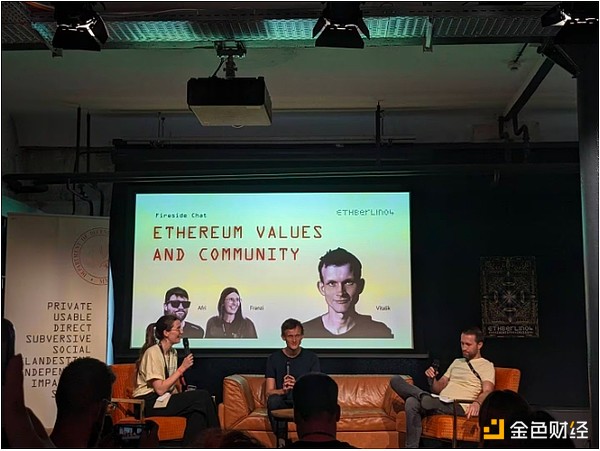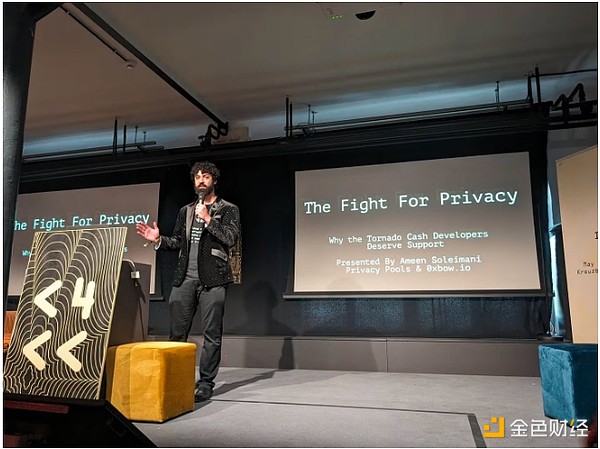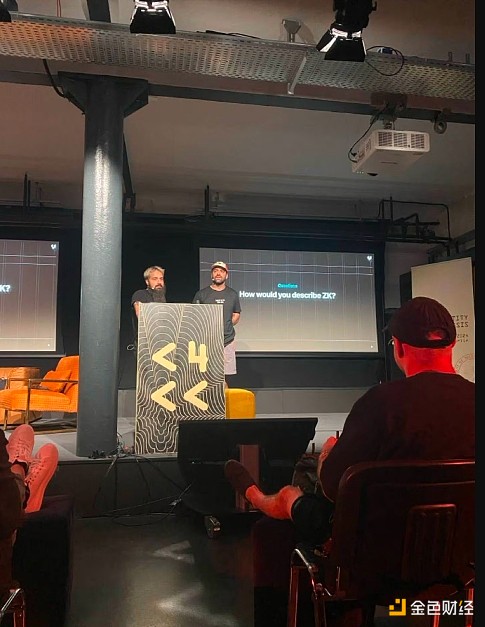Author: Liam Kelly, DL News; Translator: Tao Zhu, Golden Finance
Summary:
Ethereum architects share their thoughts on smart contracts, EVM, and other features.
Buterin says Ethereum developers should have launched proof of stake earlier.
With the advent of ETFs, Ethereum is going mainstream.
Last week, at this year's ETHBerlin event, 620 exhausted developers showed up after three days of non-stop coding, and few expected Vitalik Buterin to speak on stage.
The co-founder and chief architect of Ethereum was an unexpected guest.
Ethereum's co-founder and chief architect was an unexpected guest.
Even more surprising were some of his thoughts on building the industry's second-largest blockchain. Buterin detailed some of his regrets about Ethereum's original design.
For many in the audience, his speech not only evoked the good old days of the network’s birth in 2014, but also helped lay out a roadmap for the future of the cryptocurrency, now valued at $448 billion.
The U.S. has just approved an Ethereum spot exchange-traded fund, and BlackRock, the world’s largest asset manager, has launched its own tokenized fund on the blockchain.
The Ethereum network has spawned a massive ecosystem of developers and financial applications worth more than $63 billion, and it has become synonymous with decentralized finance.
Still, Buterin, a 30-year-old Russian-Canadian programmer, said he listed a list of things he would have done differently. These included developing the Ethereum Virtual Machine, smart contracts and a proof-of-stake consensus mechanism.
He also noted that even as Ethereum becomes more mainstream, it remains misunderstood.
“The narrative for Bitcoin is simple, it’s digital gold,” Buterin said. “But just like Ethereum, people ask ‘Wow, what the hell is Ethereum?’”
Seated on a comfy couch on stage with ETHBerlin organizers Afri Schoedon and Franziska Heintel, Buterin began the chat by sharing some of his fondest memories of the German capital over the years — hacking in the old offices with Ethereum co-founders Gavin Wood and Jeffrey Wilcke, launching Devcon Zero, and celebrating the Merge upgrade in 2022.
Then Schoedon posed a question.
“With everything you know and everything you’ve learned over the last 10 years, if you could start from scratch, how would you build Ethereum differently?” Schoedon asked.

Vitalik Buterin (center) discusses Ethereum’s vision, both past and present, during a discussion at ETHBerlin. Image credit: Liam Kelly/DL News.
Ethereum Virtual Machine
Buterin’s first concern was related to Ethereum’s virtual machine, which is the key to making the network a kind of decentralized giant cryptographic computer.
He explained that Ethereum’s original EVM design used 256-bit processing, rather than 64 or 32 bits.
In computer architecture, the size of a calculation is measured in bits, and the larger the bit, the more efficient it is, the more data it processes. But 256 bits is highly inefficient for most operations, and adds a lot of bloat to the blockchain even for simple tasks.
For the early network, Ethereum didn’t need to optimize for this.
“The original design was too good for 256 bits,” Buterin told the audience.
Optimizing Smart Contracts
Secondly, Buterin said that early Ethereum developers should focus on making it easier to write smart contracts, with fewer lines of code.
Why? Increased transparency.
With fewer lines of code, “people can properly see and inspect what’s going on inside the contract,” he said.

Volunteers and developers play music at the Berlin hackathon. Image credit: ETHBerlin.
Switch to ‘worse’ version of staking
Instead of using custom-built computers, called miners, that run nonstop to secure the blockchain network, Ethereum switched to another model.
Buterin said Ethereum’s switch from a proof-of-work consensus mechanism (the way nodes in a blockchain agree on the state of transaction data) to proof-of-stake in 2022 should have happened sooner.
“When we switched to proof-of-stake, we should have switched to a slightly worse version of proof-of-stake sooner,” he said. “We ended up wasting a lot of time trying to make proof of stake perfect.”
Now, instead of miners, ethereum is secured by validators, who stake 32 ether (worth about $124,000) to do the same thing and are rewarded for it. If they misbehave by validating fraudulent transactions, for example, they’re penalized.
All in all,the shift replaces raw, energy-intensive computing power with economic incentives.
“If we had a simpler proof of stake in 2018, we could have saved a ton of trees,” Buterin said.
Publishing logs from day one
From large token transfers to backdoor honeypots, it’s easy for users to track funds in cryptocurrency. That’s thanks in part to automated logging.
But as the industry has evolved, especially with the move away from externally owned accounts like MetaMask to smart wallets like Safe, certain key logging aspects have been lost.
Notably, there’s an automated log for Ether transfers.
“It should have been there from the beginning,” Buterin said. “Me, Gav, and Jeff could have spent 30 minutes writing the code. Instead, it’s an EIP.”
An Ethereum Improvement Proposal is a formal proposal from developers to change some aspect of the Ethereum network.
EIP-7708, submitted by Buterin on May 17, would make that precise change.

0xbow strategic advisor, MolochDAO and Reflexer Finance co-founder Ameen Soleimani is discussing the Tornado Cash case. Image source: Liam Kelly/DL News.
Ditch Keccak, Use SHA-2
Buterin also said that he would use SHA-2 as Ethereum’s hash function instead of the current function called Keccak.
To understand the difference, it’s important to dig into some cryptography, specifically about how SHA-3 became a standard. Remember, before cryptocurrency became synonymous with celebrity memecoins and nine-figure initial coin offerings, it was all about complex math.
When Ethereum was built, the hash it used was in a “hash function competition” — yes, that’s a thing.
The National Institute of Standards and Technology organized the competition to create a new hash standard in addition to SHA-2.
The previous standard had been attacked and debunked. But SHA-2 survived unscathed, and NIST just wanted a secure alternative. After all, variety is the spice of life (and of cryptography, apparently).
Keccak was just one of several contestants in the competition. During the competition, the team made some minor changes to its algorithm that ultimately made them the champions.
However, early Ethereum teams had implemented a non-standardized version of Keccak. Essentially, Ethereum was using a previous iteration of SHA-3.

ChainSafe co-founder and chief product officer Gregory Markou and Phylax Systems founder and CEO Odysseas Lamtzidis speak at ETHBerlin. Image credit: ETHBerlin
That was a hassle, right?
Well, it meant that ethereum developers needed a custom library (a collection of code that can be reused without rewriting from scratch) to accommodate both SHA-3 and Keccak.
“We were incompatible with other systems that used SHA-3,” ethereum core developer Marius van der Wijden told DL News. “We had to support both algorithms in the EVM.”
This problem has largely been solved. Today, large libraries support both cryptographic mechanisms.
So, yes, it was a hassle.
“In the grand scheme of things, it’s not important and current development certainly won’t be affected,” van der Wijden said.
Ethereum's Team
Despite a series of small design errors, Buterin said that any project is bound to have some missteps.
"I'm really happy that our core developers and their ability to execute seem to continue to improve every year," he said.
"We were able to correct some of these mistakes effectively and safely."
 JinseFinance
JinseFinance
 JinseFinance
JinseFinance JinseFinance
JinseFinance JinseFinance
JinseFinance JinseFinance
JinseFinance Edmund
Edmund JinseFinance
JinseFinance JinseFinance
JinseFinance JinseFinance
JinseFinance JinseFinance
JinseFinance JinseFinance
JinseFinance